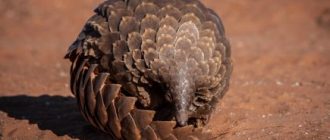
Classification
Species: Common Snipe
Family: Snipe
Order: Charadriiformes
Class: Birds
Type: Chordates
Subtype: Vertebrates
Sizes: Body length – 25 cm, wingspan – 40 cm, Weight – from 80 to 170 g
Life span: 10 years
Snipe – recognizable bird with a long thin beak and variegated brown color. Is a close relative woodcock. This sandpiper is agile in flight, capable of move quickly on land and in water.
People called him the lamb for the characteristic bleating, which he publishes during a current.
Content
- 1 Habitat
- 2 Characteristic
- 3 Appearance
- 4 Key Features
- 5 Nutrition
- 6 Behavior, reproduction
- 7 Relations with people
Habitat
Contents
With regard to the choice of habitat, the snipe is rather unpretentious bird. The main condition is high soil moisture, in which sandpiper looking for food.
Birds can be found on moss-covered swamps, on wetlands shores of lakes and rivers. They live in open glades with wet soil in rare forests and urban areas.
The habitat of birds extends across European territory, covers East Siberia and North Asia. North American a snipe subspecies is found in Canada and the USA.

Snipe settles in humid places
Snipe is a migratory bird. Their journey to wintering areas starts in late summer or early fall. Winter birds sent to Central or South Asia, Transcaucasia, Western Europe, Iran, India. There were also individuals wandering to North Africa.
If you are interested in learning about other birds that fly away autumn south, we advise you to read articlehttps: //kot-pes.com/kakie-pticy-uletayut-na-yug-osenyu/
Characteristic
The main activity is observed in snipe at dusk or at night. Individuals often come together in packs, although they do happen. and single flights. On feeding form large clusters. The animal keeps mainly on the ground, hiding among wetland vegetation.
Snipe skillfully flies and dives. Sharp soars up, letting out characteristic quack. Flies at high speed, sometimes describes zigzags in the air. Able to swiftly dive down by choosing for myself the goal.
Comparison of snipe with other species
Three subspecies of snipe are distinguished. There are slight differences in plumage: drawing and shades. Sub-species of snipe differ in size.

Snipe is slightly larger than a thrush
The size of a snipe is slightly larger than a thrush. Most close species – Asian snipe and forest hollow. At their distance almost impossible to distinguish. From the Asian snipe and its dupel It features a longer beak and a narrow head.
There are differences in plumage. Along the trailing edge of the wing white strip. The inner surface of the wings is covered with stripes. If you look closely at the pattern of feathers on the head, a white strip, resembling an eyebrow, about a beak thinner than black.
From another representative of the Bekasov family – garnshnep – Bekas can be distinguished by size (it is larger) and by the length of the beak (more than 5.5 cm), the pattern of feathers on the head (in the center stretches a bright band).
Important! Most noticeable distinctive trait of a snipe is the manner of flying. The first few meters he flies in a straight line, then goes to zigzags.
Pronounced sexual dimorphism is absent. Difference between males and females — in the length of the outer tail feathers. In males, this value is 4.7 cm, while in females – 4.3 and shorter.
Appearance
The plumage of a snipe, as seen in the photo, is predominantly reddish-brown, with light and black spots. At the tips feathers white stripes. Light, without dark spots and abdomen of a bird.
The coloring of a snipe serves him as a wonderful camouflage. If other birds have to soar into the air at the sight of danger, it can just lurking among marsh grasses.
If you are interested in looking at the incredible disguise of others animals in the wild, we recommend that you familiarize yourself with articlehttps: //kot-pes.com/maskirovka-zhivotnyh/
Snipe Long Beak
The long straight beak of a snipe immediately stands out in the photo. Its length makes up about a third of the body length – 7.5 cm. Towards the end of the beak sharpened. This is a great tool for finding food in the silt, sand or soft ground.
Finding a worm or larva, a snipe grabs it with the tip of its beak and pulls out of the soil.
About other birds with unusual beaks will tell articlehttps: //kot-pes.com/pticy-s-neobychnymi-klyuvami/
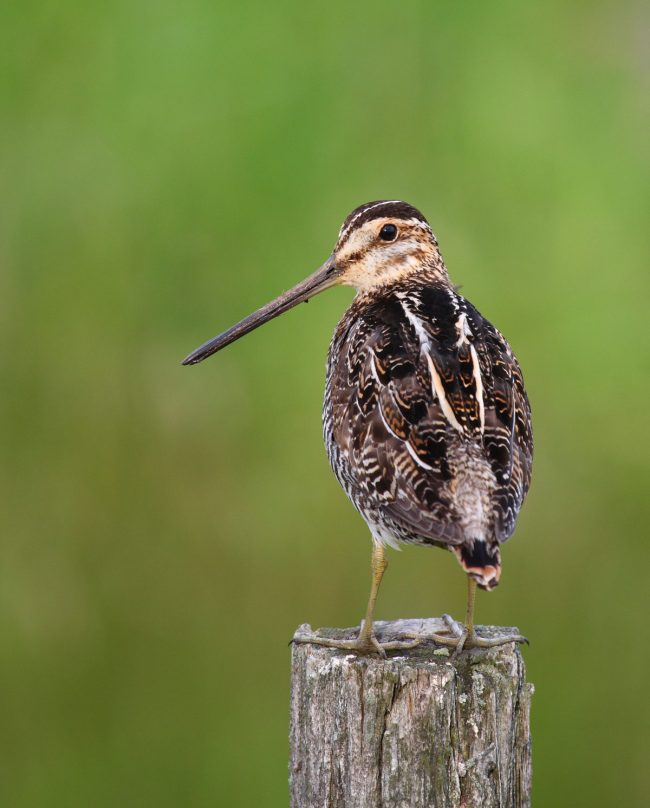
Snipe in search of food
No less interesting is the structure of the beak of a bird. Upper beak and upper the jaw is able to bend up if necessary. Although this phenomenon found in other birds, it is more pronounced in snipe.
This can be explained by the features of food searches. Unlike other birds, snipes have a well-developed sense of smell. They distinguish odors due to sensitive receptors at the tip of the beak.
The body of individuals is relatively small, about 25 cm long or slightly more. The legs are short. The large eyes of the bird are set high and noticeably shifted to the back of the head, giving a wide view.
Key Features
Among other forest birds, snipe are distinguished by the following features.
- This sandpiper is unpretentious and lives on swamps, coasts with moist soil and rare forests.
- Its nickname “forest lamb” snipe received because of the characteristic a sound that resembles bleating. And he doesn’t publish it vocal cords, and tail feathers. When during courtship games the male, gaining height, dives down, feathers begin to vibrate. IN the result is the same “bleating” sound.
- Large, high-set eyes not only give birds wide review, but also allow you to see at dusk.
- The tip of a snipe’s beak can open even if it is closed along the entire length. Thanks to this, the bird takes prey from the thickness of sand or silt.
- Snipe – a true master of flight, he is agile in the air and describes real zigzags. It is worth noting that he is agile and after completion of the current. The bird swiftly moves through the air changing the height from time to time.
- These birds are monogamous. Although only a female is involved in hatching, Both parents are involved in the care of the offspring.
- During a mating dance, a snipe can dive down from a height about 70 meters.
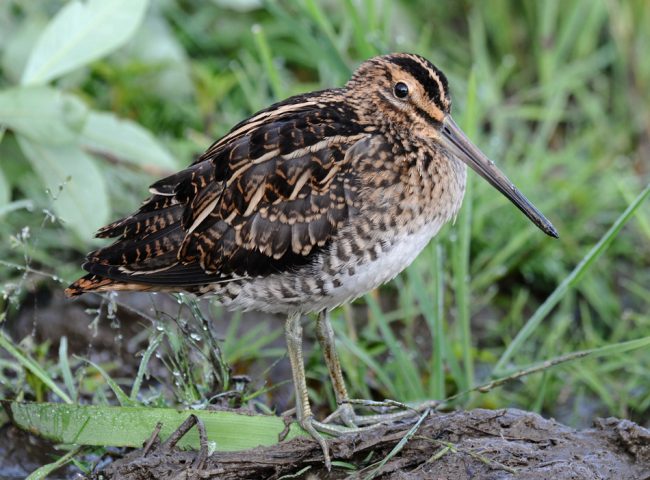
Snipe eyes set high
Food
The main part of the snipe diet is insects and their larvae, earthworms, to a lesser extent – small crustaceans and mollusks. Along with animal feed, they use vegetable, in particular seeds and shoots plants.
Important! To improve the grinding of greens in stomach, birds swallow small grains of sand and pebbles.
The snipe coming out to feed actively moves, catches small insects. To find food, he examines the soil, immersing it beak almost to the base. Finding a large prey, for example the worm, beak divides it into small pieces.
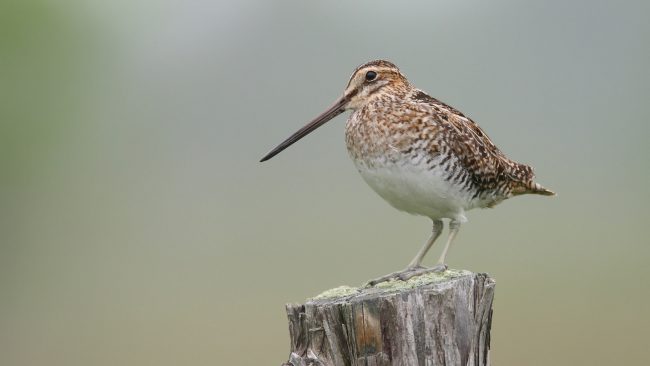
Beak needs a beak when looking for food
In search of food in shallow water, the snipe launches its long a sharp beak in soft silt and, slowly moving forward, checks the soil.
At the tip is a large number of nerve endings, which will allow you to catch the movement of earthly inhabitants. Feeling prey, snipe captures her beak. He can swallow food, not pulling beak out of silt.
Behavior, reproduction
Snipe early return from wintering. It happens as soon as snow begins to melt and the first thawed patches form. Observed mating during flights.
When they reach the nesting site, current immediately begins. Individuals occupy territory for their family, often overlapping while the boundaries of the neighbors’ plot. Subsequently, the males commit spans over its territory, indicating to everyone that it is busy.
Snipe is a predominantly silent bird. His tweets are possible hear only during the current period.

Snipe hiding in the grass
After wintering, snipe return to their nesting sites. Males arrive first and occupy the site for the future nest. Then current begins.
Sniping period
Snipe monogamous and form stable pairs for the entire period nesting. During the current period, the male performs breathtaking in the air marriage dance. He rises high up, describes a few circles, then almost vertically falls down.
At this moment, he slightly presses his wings, and the tail opens. At the same time, his feathers begin to vibrate loudly, making a sound, reminiscent of bleating. The current continues on earth. Male seated on a hill and tweeted loudly.
Important! Snakes are especially active in the morning and in the evening with high humidity, with cloudy weather and light rains.
After mating, the female joins the male. Snipe nesting in different territories: in swamps, rare forests with clearings and shrubs overgrown with sedge.
The pair stays together throughout the entire breeding season. The female takes care of the nest entirely, she also hatching eggs. The male continues to current, indicating that it their territory.
Nesting and offspring care
The female arranges the nest on a bump near the reservoir, as usually in thick grass. It is a small hole, dug in the ground and strewn with straw.
In some areas, litter may literally consist of several blades of grass, but at high humidity its thickness reaches two centimeters. A hole is dug with a diameter of 10-13 cm, height nests about 5 cm.
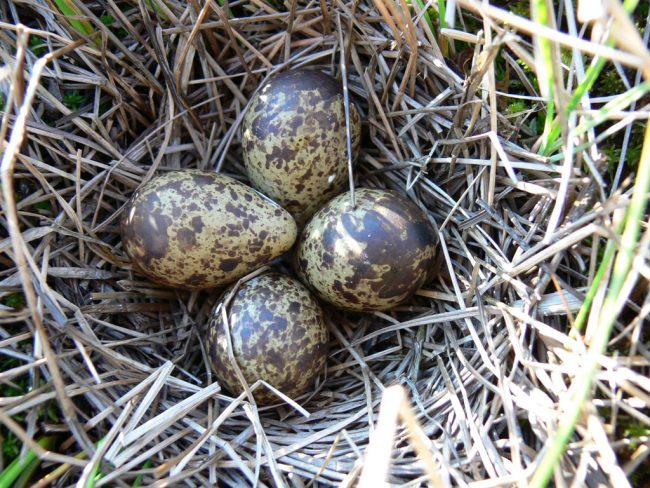
There are 4 motley eggs in the nest
The female covers the nest from above with closely spaced blades of grass, the result is a small hut. Camouflage color birds and the location of the nest makes them almost invisible.
In case of danger, the female takes off sharply, then dives into the grass and hides in it. Despite the big difference between species, the behavior of snipe and the very principle of nesting in this respect is very much like bustard.
What do snipe eggs look like?
The bird lays 4 eggs of olive or yellow color with dark interspersed. In rare cases, masonry containing 3 or 5 eggs. It is assumed that the found clutches with 6 eggs belong to to several females.
Snipe-shaped pear-shaped eggs. The shell is matte or with light shine. By weight, eggs reach 17 g. lasts 17-20 days, only the female is engaged in it.
Hatching and development of chicks
The little chicks are covered in fluff, but they are good enough developed. They crawl out of the nest as soon as they dry. Male and female divide the brood in half and everyone takes care of his pair chicks.
Toddlers need to be fed and heated. In the event of the death of one of parents, the second completely takes care of the offspring.
Already at the age of one month, chicks begin to learn to fly. Young growth it fins relatively quickly and leaves a nest. However, in in case of danger, the parents themselves move the chicks to a safe a place. They grab them between their paws, while flying low above ground.
Young individuals in appearance are little different from adults. If mature birds have light wings on the upper covering wings rounded blotches, then young animals have reddish stripes. Generally the plumage of a young snipe is a little darker.
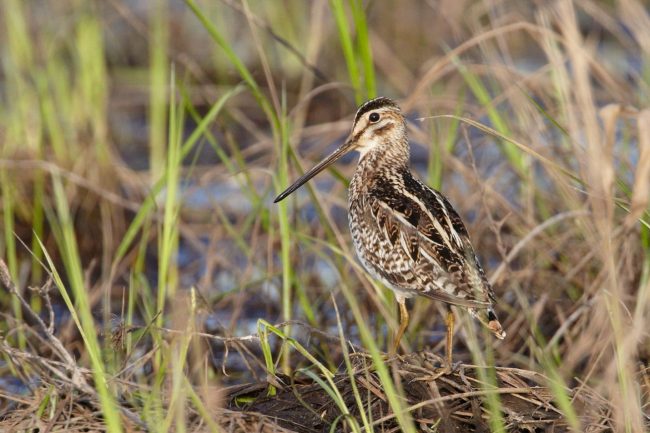
The plumage of birds changes little with age
Even before the departure to the wintering places, the chicks begin to lead nomadic lifestyle. They have a certain schedule. IN evening time, birds go to feeding, which lasts all night. At dawn, they hide in thickets of grass.
Interesting! Seeing danger (e.g. approaching the enemy), chicks bow their heads to the grass. At that time parents either drive him away or take him away from the nest.
Preparing for the flight to wintering places
In mid-summer, molting occurs in adults, during which their plumage is completely replaced. At such a time they especially neat and hide in hard to reach places.
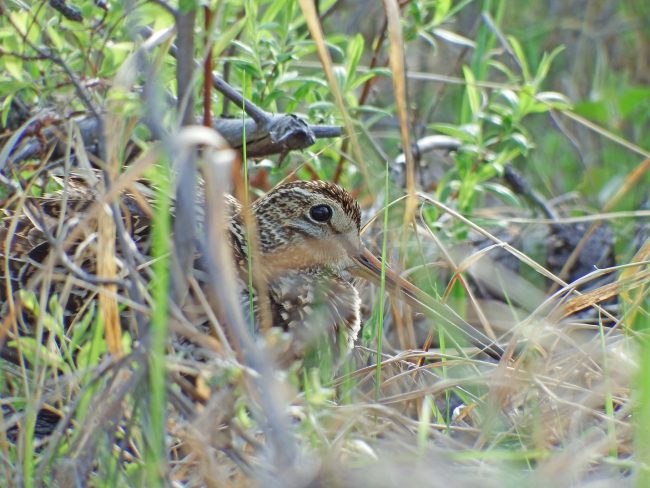
Snipe – master of disguise
Flight to wintering places occurs at the end of summer-fall, although some individuals, it can continue until the first frost.
Snipes are kept alone or in small flocks for about 6 birds. Fly mainly at night. Periodically they stop for rest, dozens gather at stopping places individuals.
Relationship with people
Snipe is a popular sport hunting destination. However, their abundance remains high enough so these birds do not listed in the Red Book. In general, snipe is cautious and shy bird.
Snipe – an interesting representative of the snipe family. This bird stands out for its long beak and unique singing during marriage dance.
This is a true virtuoso of flying. Starting in the air straight line, he goes to the rapid zigzags. After him it is no coincidence that the nickname “forest lamb” has entrenched itself. Voiced the vibration that his feathers produce when diving down, distinguishes it from all other birds.






